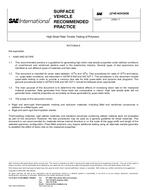Click here to purchase
This recommended practice is a guideline for generating high strain rate tensile properties under defined conditions of unreinforced and reinforced plastics used in the automotive industry. Several types of test specimens are identified to suit different types of materials and test rates. This document is intended for strain rates between 10\u-\u33/s and 10\u3/s. Test procedures for rates of 10-2/s and below; i.e., quasi-static conditions, are described in ASTM D 638 and ISO 527-1. The procedures in this document include quasi-static testing in order to provide a common test rate for both quasi-static and dynamic test programs. The general procedures listed in ASTM D 638 and ISO 527-1 should be followed when appropriate.The main purpose of this document is to determine the relative effects of increasing strain rate on the measured material properties. Data generated from these tests are comparative in nature. High rate tensile tests will not generate basic material properties as accurately as those generated by quasi-static tests.The scope of this document covers: Rigid and semi-rigid thermoplastic molding and extrusion materials, including filled and reinforced compounds in addition to unfilled types, and rigid and semi-rigid thermoplastic sheets.Thermosetting materials, rigid cellular materials, and sandwich structures containing cellular material were not evaluated as part of this document. However, the test procedures may be used as a general guideline for these materials. This document is not recommended for materials whose internal structure is on the scale of the gage width and length of the selected specimen configuration. Fiber-filled polymers may require additional testing using an alternate sample geometry to establish the effect of strain rate on the measured properties.
Product Details
- Published:
- 11/26/2008
- File Size:
- 1 file , 2.3 MB

